Suzuki GSX-R 1000 Service Manual: Radiator / cooling fan motor removal and installation
Removal
- Remove the inner under cowlings. Refer to “exterior parts removal and installation” in section 9d .
- Drain engine coolant. Refer to “cooling system inspection” in section 0b .
- Disconnect the reservoir tank inlet hose (1) and water air bleed hose (2).
- Remove the radiator reservoir tank (3).
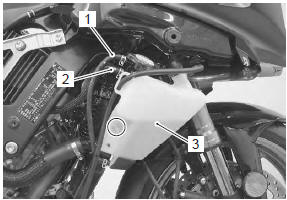
- Disconnect the radiator inlet hose (4).
- Disconnect the cooling fan motor coupler (5).
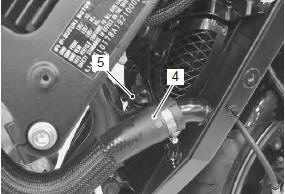
- Remove the oil cooler (6) from the bracket.
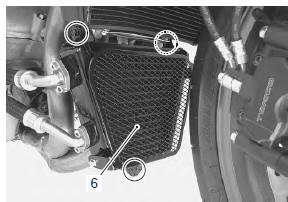
- Remove the radiator assembly by removing the bolts.
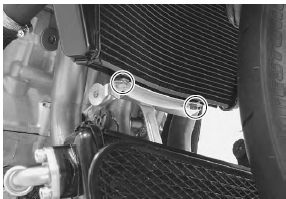
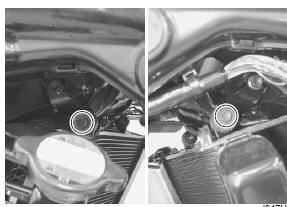
- Remove the radiator outlet hose (7) and cooling fan motor (8) from the radiator.
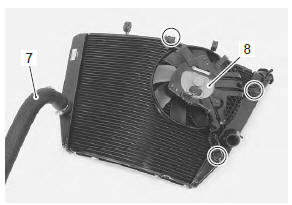
Installation
Install the radiator in the reverse order of removal. Pay attention to the following points:
- install the radiator and oil cooler to their bracket. Refer to “radiator inspection and cleaning” .
- Apply thread lock to the reservoir tank bolt and tighten it securely.
 : Thread lock cement
: Thread lock cement
99000–32110
(thread lock cement super “1322” or
equivalent)
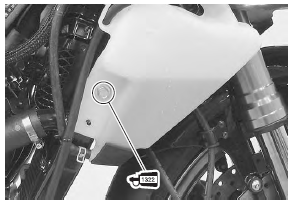
- Connect the radiator hoses securely. Refer to “water hose routing diagram” .
- Pour engine coolant. Refer to “cooling system inspection” in section 0b .
- Bleed air from the cooling circuit. Refer to “cooling system inspection” in section 0b .
 Radiator inspection and cleaning
Radiator inspection and cleaning
Radiator hose inspection
Refer to “cooling system inspection” in section 0b .
Radiator inspection
Inspect the radiator for water leaks. If any defects are
found, replace the radiator with a new on ...
 Water hose inspection
Water hose inspection
Inspect the water hoses in the following procedures:
remove the side cowlings. Refer to “exterior parts
removal and installation” in section 9d (page 9d-
6).
Check the water hose ...
Other materials:
Engine components removable with the
engine in place
Engine components which can be removed while the engine is installed on the
frame are as follows. For the installing
and removing procedures, refer to respective paragraphs describing each
component.
Center of engine
Item
Removal
Inspection
Installation
...
Chassis bolt and nut inspection
Tighten chassis bolt and nut
initially at 1 000 km (600 miles, 2 months) and every
6 000 km (4 000 miles, 12 months) thereafter
Check that all chassis bolts and nuts are tightened to
their specified torque.
Steering stem
lock-nut 80 n·m (8.0 Kgf-m, 58.0 Lbf-ft)
Stee ...
Cylinder head related parts inspection
Refer to “cylinder head disassembly and assembly” .
Cylinder head distortion
Decarbonize the combustion chambers.
Check the gasket surface of the cylinder head for
distortion. Use a straightedge and thickness gauge.
Take clearance readings at several places. If
readings exceed the ...
